Living in Minnesota and heard some birds but are not sure which ones they were?
Minnesota is known for its wildlife, and according to the Minnesota Ornithologists’ Union Records Committee (MOURC), there are almost 450 species of birds there.
Examples of songbirds of Minnesota include purple martin, eastern bluebird, horned lark, house finch, scarlet tanager, northern parula, American robin, and many others.
Year-round songbirds of Minnesota include white-breasted nuthatches, black-capped chickadees, house finches, and others.
Summer songbirds of Minnesota include purple martins, barn swallows, house wrens, eastern bluebirds, and others.
Winter songbirds of Minnesota include dark-eyed juncos, common redpolls, and others.
In this post, you will find photos, identification info, bird calls and songs, and all the fun information you need.
Table of Contents
Songbirds Of Minnesota
Purple Martin
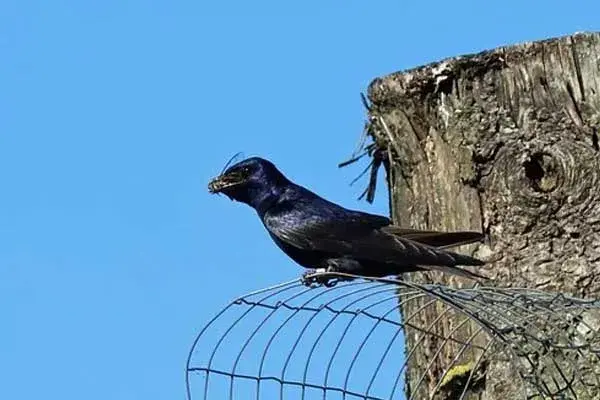
- Scientific name: Progne subis
- Lifespan: 5-7 years
- Wingspan: 15 in
- Range In Minnesota: Throughout Minnesota
Purple martins, the largest swallows in North America, are migratory songbirds with glossy purple-blue plumage. Females are gray to mottled purple.
They have forked tails, slightly hooked beaks, and long pointed wings.
Purple martins are breeding residents of Minnesota and can be seen around suburban areas with martin houses. The best time to see them would be during summer, from May to July.
First to arrive in the state are males, around April, followed by females a few days later. They will breed there during summer and gather in huge groups before undertaking a 7,000-mile-long journey to South America for winter.
Purple martins are very vocal birds.
Their most common songs are chirps, chortles, rattles, and croaks. When fighting over territory, purple martins will make a “hee-hee” sound and a “zwrack” call when interacting with other species.
Source: Jonathon Jongsma, CC BY-SA 3.0, via Wikimedia Commons
Due to habitat loss, purple martins today almost exclusively house in artificial nests.
Males will scout for new or unoccupied houses, but the females are the ones that make the final decision. Pairs typically build their nests out of straw, twigs, and pine needles.
They are very social and colonial birds – the largest roosting colony ever discovered had over 700,000 birds!
Purple martins are carnivores that use the hawking strategy to catch insects – they will swoop down and catch them mid-flight.
Barn Swallow

- Scientific name: Hirundo rustica
- Lifespan: 4 years
- Wingspan: 12.5-13.5 in
- Range In Minnesota: Throughout Minnesota
Barn swallows, the most widespread swallows in the world, are easy to identify by their forked tails, dark blue upperparts, rusty throats, and cinnamon-colored bellies.
Barn swallows are Minnesota songbirds that breed in the state during summer. The best time to see them there would be from early April to late October. They inhabit various areas, especially near water.
Males are the first to return to the breeding grounds from Central and South America. They will select their nests and try to attract females with a circling flight and their song.
Barn swallows have a “twitter-warble” song during the breeding season that consists of a long series of continuous warbling sounds and rapid, mechanical-sounding “whirrs.”
Source: Record by Justin Wasack as stated on this site: http://www.freesound.org/samplesViewSingle.php?id=74868, CC BY 3.0, via Wikimedia Commons
Barn swallows build open-cup nests using mud and dried grass. They used to nest around caves and rocky crevices, but today, they mainly use man-made structures that have overhanging eaves or flat surfaces.
According to the legend, barn swallows stole fire from the gods and gave it to people. Gods became so angry that they threw a firebrand at the bird, burning its middle tail feathers.
Read More: Examples of birds with deeply forked tails
Cliff Swallow
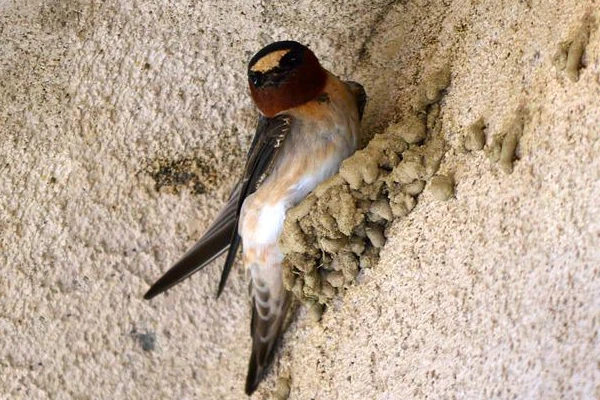
- Scientific name: Petrochelidon pyrrhonota
- Lifespan: up to 11 years
- Wingspan: 13.5 in
- Range In Minnesota: Throughout Minnesota
Cliff swallows are gregarious songbirds with broad pointed wings, small heads, and squared tails. They have dark brown upperparts, maroon-colored throats, white foreheads, and streaked backs.
Cliff swallows are breeding residents of Minnesota that can be seen around steep banks, cliffs, bridges, and buildings near the waterways of the state.
They arrive in Minnesota to breed in mid-April and migrate in early October to wintering grounds in South America.
The song of cliff swallows is a 6-second-long series of guttural grating sounds and squeaks. They also have several calls, including the alarm call, begging, recognition, and squeak call; the most common one is a soft “chur“.
Source: Jonathon Jongsma, CC BY-SA 4.0, via Wikimedia Commons
They are very social birds that can form large groups and create colonies ranging from a few hundred to a few thousand nests.
Occasionally, cliff swallows may lay eggs in other swallows’ nests for them to raise their chicks.
These birds found in the Northeast are insectivores and mainly consume flies, bees, moths, butterflies, grasshoppers, etc.
House Wren
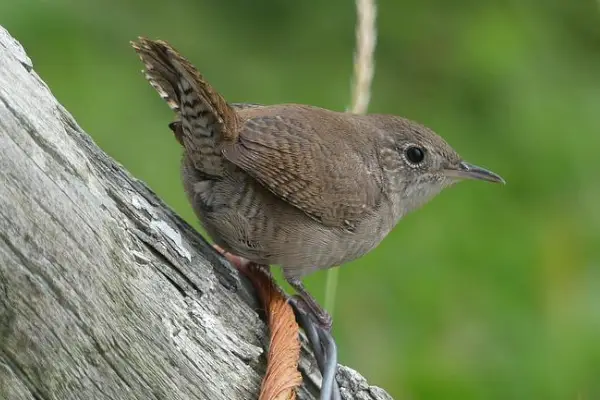
- Scientific name: Troglodytes aedon
- Lifespan: up to 7 years
- Wingspan: 6 in
- Range In Minnesota: Throughout Minnesota
House wrens are one of the most common songbirds of Minnesota. They are brown above, grayish below, and have barrings on their wings and tails. Their heads are flat, beaks are curved, and short tails are usually held cocked.
House wrens are summer residents of Minnesota and can be seen in habitats ranging from forests to gardens. They breed in the state from April to July and you see them there from March to mid-October.
House wrens are famous for their rush-and-jumble songs and will often make different harsh sounds: churrs, chatters, rattles, and scolds.
Source: Jonathon Jongsma, CC BY-SA 3.0, via Wikimedia Commons
There are 32 subspecies of house wrens in total.
They might never visit your bird feeder but house wrens will fly through your backyard hunting insects. Most of their diet includes insects, spiders, and snails.
If you want to attract house wrens to your yard, try adding a bird house.
Among other places, house wrens are one of many birds commonly found in Northern California, Central Florida, and Northeast Ohio.
White-breasted Nuthatch
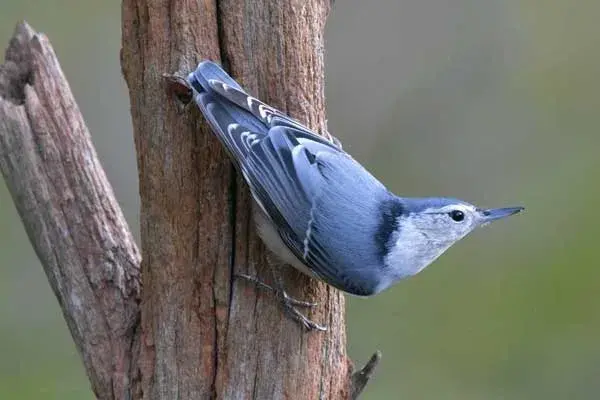
- Scientific name: Sitta carolinensis
- Lifespan: 2 years
- Wingspan: 7.9–10.6 in
- Range In Minnesota: Throughout Minnesota
White-breasted nuthatches are medium-sized nuthatches and small songbirds that measure just 6 inches in length. They have small tails and almost no necks which make them look very stocky.
These nuthatches are blue-gray above, white under, and have wedged bills, dark crowns, white faces, and rufous vents. Females are lighter than males.
White-breasted nuthatches are permanent residents of Minnesota and can be seen there throughout the year, in forests and suburbs. They prefer deciduous trees which makes them less common in the northeastern parts of the state.
White-breasted nuthatches have a song that consists of a rapid series of low, nasal, whistled notes that sound like “whi-whi” or “who-who.” Often, males will sing rapidly in the spring when they are trying to attract a mate.
Source: G. McGrane, Public domain, via Wikimedia Commons
These quirky and loud birds got their name from the way they crack open seeds – they will jam their seeds and nuts into tree bark, and then whack it with their beaks to open them.
White-breasted nuthatches are omnivores that feed on insects and seeds. They often visit backyard bird feeders so if you are lucky to attract them, their quirky personalities will provide you with endless entertainment.
There are 9 subspecies of white-breasted nuthatches.
Black-capped Chickadee

- Scientific name: Poecile atricapillus
- Lifespan: 2-3 years
- Wingspan: 6-8 in
- Range In Minnesota: Throughout Minnesota
Black-capped chickadees are small backyard songbirds that have rounded bodies, large heads, and short necks. They have black caps, black throat patches, white cheeks, and buffy flanks.
Black-capped chickadees are permanent residents of Minnesota, common around forests and gardens of the state. Their breeding season lasts from April to early August.
Black-capped chickadees got their name for the black caps on their heads and the distinctive “chickadee-dee-dee” calls. If you hear more “dee” notes, that means the bird is giving a warning call.
Source: Jonathon Jongsma, CC BY-SA 3.0, via Wikimedia Commons
Black-capped chickadees are the state birds of Massachusetts and Maine in the US and the provincial birds of New Brunswick in Canada.
They are also one of the more useful birds in the orchard or forest as they eat different pests, including insect eggs, larvae, weevils, lice, sawflies, and also some snails, slugs, and spiders.
Pairs are usually monogamous and may remain together for several breeding seasons. In the early spring, the male will even feed the female. They are cavity nesters and have one clutch of 5-10 white eggs with brownish spots.
These nonmigratory songbirds might visit your backyard feeder. If you want to enjoy black-capped chickadees’ inquisitive behavior and friendly demeanor, make sure to add sunflower seeds, peanuts, suet, peanut butter, and mealworms to your feeder.
Golden-crowned Kinglet
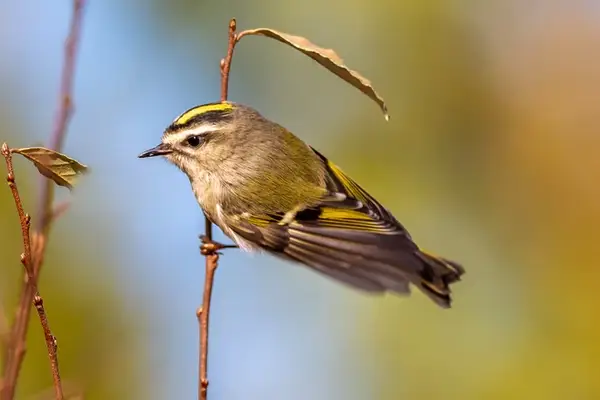
- Scientific name: Regulus satrapa
- Lifespan: around 5 years
- Wingspan: 5.5-7.1 in
- Range In Minnesota: Northern and Southern Minnesota
Golden-crowned kinglets are tiny songbirds, one of the smallest in the United States. They are greenish-gray above and grayish below; males have black eyelines, white eyebrows, and fiery orange crowns while females have yellow crowns.
Golden-crowned kinglets are common around the forests of Minnesota. They breed in coniferous forests and woodlands in northwestern parts and migrate to winter in coniferous, deciduous, and mixed forests and woodlands of southern parts.
They migrate from mid-March to mid-May and from early September to early December.
Golden-crowned kinglets’ song consists of a series of very high-pitched “tsee” notes.
Source: G. McGrane, Public domain, via Wikimedia Commons
These tiny birds are active foragers in trees and shrubs; their diet consists of insects, insect eggs, and spiders.
Golden-crowned kinglets are also noted for their remarkable ability to survive cold weather and temperatures as low as -40°F.
Eastern Bluebird
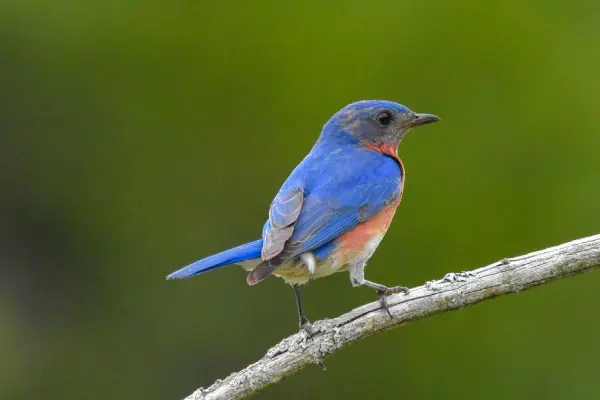
- Scientific name: Sialia sialis
- Lifespan: 6-10 years
- Wingspan: 9-12 in
- Range In Minnesota: Throughout Minnesota
Eastern bluebirds are the only of the three North American bluebird species commonly found in Minnesota. They are bright blue above and have orange throats and breasts; females have duller colors.
Eastern bluebirds are small songbirds that can be seen from spring to fall in Minnesota. They can be seen from early March to early November, around cropland fencelines, meadows, pastures, forest edges, and gardens.
The song of the eastern bluebirds is a soft melodious warble while their call is a liquid and musical “turee” or “queedle.”
Source: Jonathon Jongsma, CC BY-SA 3.0, via Wikimedia Commons
To attract a female, a male bluebird will sing over 1,000 songs per hour.
They are cavity nesters that love nest boxes and very social birds that can live in flocks with over 100 individuals.
Eastern bluebirds are omnivores that mostly feed on insects, including grasshoppers, crickets, beetles, caterpillars, and some fruit.
Attract eastern bluebirds to your backyard by adding mealworms to your feeder, they love to eat them.
These small blue and orange birds are the official birds of Missouri and New York.
Read More: 25 stunning birds common in Upstate New York and 75 most common NYC birds
Eastern Phoebe
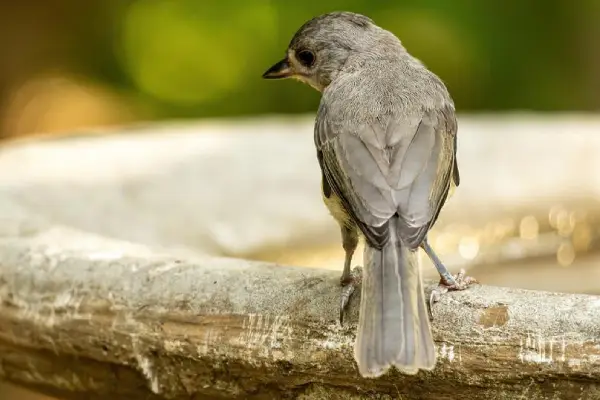
- Scientific name: Sayornis phoebe
- Lifespan: up to 10 years
- Wingspan: 10-11 in
- Range In Minnesota: Throughout Minnesota
A welcome sight in Minnesota, eastern phoebes are small songbirds with large heads and medium-long tails. They have grayish heads and bodies and white bellies, and two buff bars on their wings.
Eastern phoebes are breeding residents of Minnesota and can be seen in woods, suburbs, and parks of the state, from spring to fall. They are common there from mid-March to early November when they migrate to winter in the southern US.
The song of eastern phoebes is a two-noted “fee-bee” they were named from; they also have a sharp “chip” call.
Source: G. McGrane, Public domain, via Wikimedia Commons
Look for birds that sit upright and often pump (wag) their tail after landing.
Eastern phoebes tend to avoid open areas and prefer spots under trees, brushy areas, and overhangs.
These birds will use mud, grass, and moss to build their nests and will attach them to the sides of limestone outcroppings or under rock ledges.
They usually have two broods per year, and each clutch will have 2-6 eggs.
Eastern phoebes are omnivores and feed on insects and some fruits.
Horned Lark
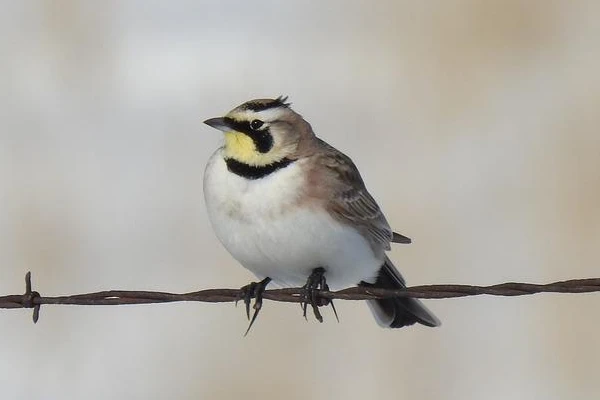
- Scientific name: Eremophila alpestris
- Lifespan: up to 8 years in the wild
- Wingspan: 11.8-13.4 in
- Range In Minnesota: Central and Southern Minnesota
Horned larks are small songbirds that are also known as “shore larks” in Europe. They have tan upperparts, white underparts, black masks and bibs, and yellow chins. They were named after the black “horns” males have during summer.
Horned larks are summer residents of Central Minnesota and permanent residents in its southern parts. They are common around open lands without trees, including prairies, agricultural fields, weedy meadows, and even airports.
Horned larks have a delicate musical song consisting of several chips followed by a warbling trill. They will also emit high-pitched “chip” calls when flying.
They are social birds that gather in flocks, sometimes with other songbirds. Look for birds running along the ground in open areas with little to no vegetation.
Horned larks are omnivores that mainly consume seeds and arthropods found on the ground.
They will build their nests in small holes in the ground and decorate them with small pebbles or corncobs.
There are 42 recognized subspecies of horned larks.
Eastern Kingbird
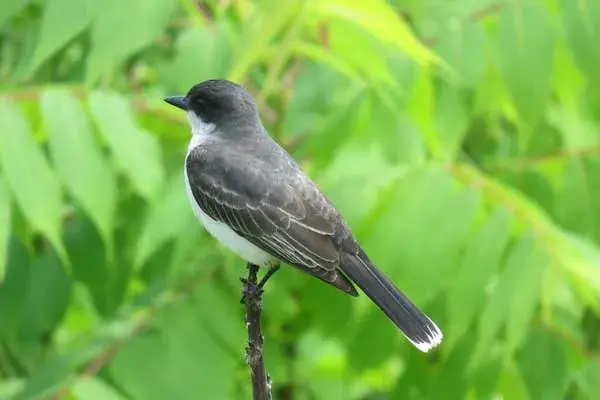
- Scientific name: Tyrannus tyrannus
- Lifespan: up to 11 years
- Wingspan: 13-15 in
- Range In Minnesota: Throughout Minnesota
Eastern kingbirds are large flycatchers native to North, Central, and South America. They are slaty above, white below, and have dark caps on their heads and white bands at the tips of their tails.
The name “kingbird” comes from the birds’ crowns.
Eastern kingbirds are Minnesota songbirds commonly found in the open country, farms, and fields of the state from spring to fall. Look for them from mid-April to late September.
After spending summer in the state, they will migrate to spend winter in South America, primarily northwestern Amazonia.
Eastern kingbirds have a song that consists of high, sputtering notes; their calls include the high-pitched “kit-kit” and “dzee-dzee” sounds.
Source: Jonathon Jongsma, CC BY-SA 3.0, via Wikimedia Commons
They will often perch on wires, watch for large insects, and make quick flights to snatch them. Eastern kingbirds also feed on berries and fruit, mainly during winter.
They are very aggressive and territorial and will chase away any bird that enters their territories, including large ones like hawks and crows.
Eastern kingbirds are also one of the many examples of stunning black and white birds in Colorado.
Indigo Bunting
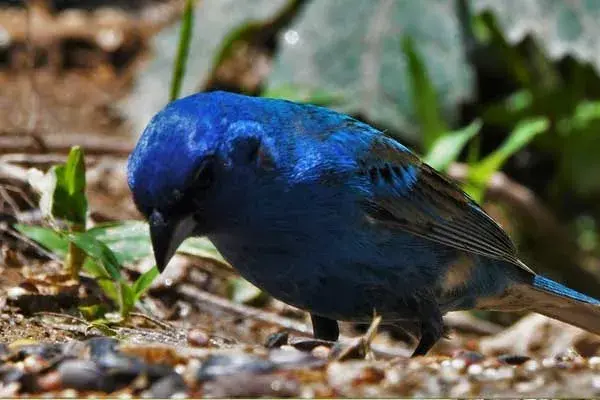
- Scientific name: Passerina cyanea
- Lifespan: 10 years
- Wingspan: 7-9 in
- Range In Minnesota: Throughout Minnesota
Indigo buntings are gorgeous songbirds of Minnesota that are easy to identify when out in the sun. Males are vivid blue with the most intense color on their heads. Females are brown with fine breast streaks.
Indigo buntings are summer breeders in Minnesota and can be seen around woodlands, forests, and parks of the state. They are common there from May to mid-October.
After breeding in the States, they migrate to winter in Central America, the Caribbean, and occasionally in northern South America.
Indigo buntings’ song is a rapid, excited warble with each note or phrase being given twice.
When marking their territory or attracting females, male indigo buntings will emit a high-pitched song that lasts from two to four seconds and sounds like “sweet-sweet chew-chew.” Both sexes will also use a sharp “chip” alarm call.
Source: G. McGrane, Public domain, via Wikimedia Commons
Indigo buntings are territorial birds and omnivores that feed on insects, seeds, and berries.
Because of their bright blue color, many people consider indigo buntings symbols of wisdom and spiritual realization.
These birds usually mate for life; occasionally, they may switch partners within a single breeding season.
Scarlet Tanager
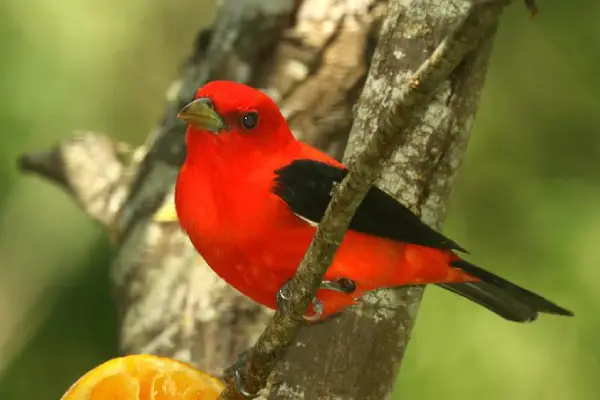
- Scientific name: Piranga olivacea
- Lifespan: up to 11 years
- Wingspan: 10-12 in
- Range In Minnesota: Throughout Minnesota
Scarlet tanagers almost became the state birds of Minnesota, back in the 1950s. The state legislature debated selecting them as state birds but ultimately opted for common loons.
These medium-sized songbirds have thick, rounded beaks, fairly large heads, and short and broad tails. Males are bright red with black wings and tails; females are lime to yellow-green with white wing linings, and gray flank.
Scarlet tanagers are summer residents of Minnesota, common around mature deciduous forests, mixed forests, and gardens of the state. They stay there from May to early October before departing to winter in northwestern South America.
First to arrive at their breeding grounds are males, followed by females a week later. After breeding, the pair will have a clutch of around 4 light blue eggs with a green tinge.
Male scarlet tanagers have a song consisting of a series of 4-5 chirruping phrases with a hurried quality. Females will sing more softly. People often compare scarlet tanagers’ song to one of a robin with a sore throat. The call is a distinctive “chip-burr.”
Source: G. McGrane, Public domain, via Wikimedia Commons
Scarlet tanagers forage high in trees and primarily feed on insects and some fruit.
Dark-eyed Junco
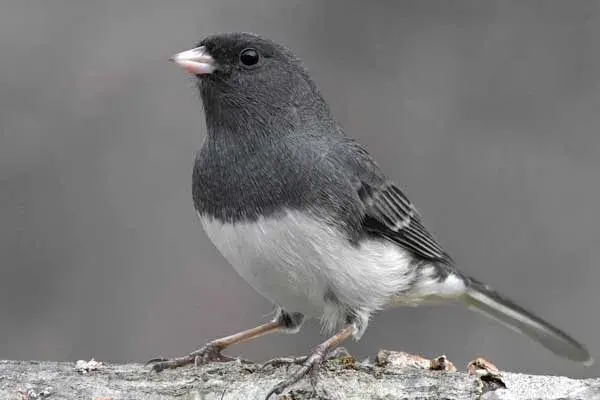
- Scientific name: Junco hyemalis
- Lifespan: 3-11 years
- Wingspan: 7.1-9.8 in
- Range In Minnesota: Throughout Minnesota
Dark-eyed juncos are small songbirds and medium-sized sparrows. There are around 15 recognized subspecies that look similar and make taxonomists’ lives a misery.
The subspecies found in Minnesota are the slate-colored dark-eyed juncos (J. h. hyemalis).
They are dark gray above, white bellow, and have pale beaks and flashes of white in outer tail feathers.
Dark-eyed juncos are winter residents of central and southern Minnesota; some populations living in the northwestern parts can be seen there year-round.
They are common around coniferous and mixed forests, Jack Pine stands, and shrubby woodland clearings.
The song of male dark-eyed juncos is a strong musical trill that lasts around two seconds and consists of up to 20 notes. Both sexes usually have a quieter song that includes different whistles, trills, and warbles. Their calls include high-pitched “chip” and “tick” sounds.
Source: G. McGrane, Public domain, via Wikimedia Commons
They often forage while hopping and running on the ground and might even scratch the ground/snow with their feet in pursuit of food.
Dark-eyed juncos are nicknamed “snowbirds” because they’re commonly sighted in winter throughout North America.
They are omnivores that mainly feed on seeds, and some insects in summer.
Yellow Warbler

- Scientific name: Setophaga petechia
- Lifespan: up to 10 years
- Wingspan: 6.3-8.7 in
- Range In Minnesota: Throughout Minnesota
Yellow warblers are one of the most widespread New World warblers. These small songbirds have thin beaks, rounded heads, and medium-long tails.
Males are yellow with red streaks on breasts; females and immatures have duller colors and lack streaks.
Yellow warblers are summer residents of Minnesota that can be seen in open woodlands with willow and dense, low scrub, shrubby meadows with willow.
They are common there from late April to early September and later migrate to winter in Southern California, Central, and South America.
Their bright and sweet song can be often heard near riparian habitats. To attract females, male yellow warblers will produce over 3,000 whistling songs per day.
Male yellow warblers will sit perched near the tops of bushes or trees and sing their song that sounds like “sweet-sweet-I’m-so-sweet”.
Source: G. McGrane, Public domain, via Wikimedia Commons
On the other hand, when defending their territories, males will make loud “hissing” calls.
Yellow warblers are diurnal birds and omnivores, feeding on insects such as leafhoppers, beetles, wasps, midges, and caterpillars. During winter, they might also eat some berries and fruits.
These small yellow birds are monogamous and stay together for life. The female will build the nest and incubate 4-5 eggs while the male feeds her. Both parents will take care of the young.
They are susceptible to brood parasitism by brown-headed cowbirds where these small black birds lay their eggs in the warblers’ nests.
Since they are too small to get the cowbird eggs out, yellow warblers will simply build a new nest on top of the old one.
House Finch

- Scientific name: Haemorhous mexicanus
- Lifespan: up to 11 years
- Wingspan: 8-10 in
- Range In Minnesota: Throughout Minnesota
House finches are small songbirds with short wings, conical beaks, and shallowly split tails.
Males have streaky red breasts, red eyebrows, foreheads, and rumps, while females are brown above and streaked below; they have no red.
House finches are permanent residents of Minnesota and can be seen in urban and suburban areas, and rural areas with buildings and lawns. Although found statewide, house finches are more common in southern Minnesota.
Male house finches’ song is a long, jumbled warbling consisting of short notes. Their call is a sharp “cheep.”
Source: Jonathon Jongsma, CC BY-SA 3.0, via Wikimedia Commons
Depending on the location, house finches have different “accents” while singing; songs in some parts of the US can last longer and have more syllables.
They are gregarious and loud birds that can be seen around large flocks.
House finches are omnivores and feed on seeds, buds, flower parts, berries, small fruits, and occasionally some small insects.
During the non-breeding season, you might also see flocks of house finches around bird feeders. If you want to attract one, make sure to add black oil sunflower seeds, millet, and milo.
The red color of the males comes from the berries and fruits in their diet – females prefer to mate with males that have the reddest faces.
Black-throated Green Warbler

- Scientific name: Setophaga virens
- Lifespan: up to 6 years
- Wingspan: 6.7-7.9 in
- Range In Minnesota: Northeastern Minnesota
Black-throated green warblers are lovely warblers of Minnesota’s northeastern coniferous forests. Males are green above with yellow faces, black throats, streaked flanks, and white wing bars; females have duller plumage.
Black-throated green warblers are breeding residents in northeastern Minnesota; they can be seen migrating during spring and fall in other parts of the state. The best time to see them would be from late April through May and from mid-August to October.
After breeding in the deciduous, coniferous, and mixed forests of Minnesota, they will migrate south to winter in the Caribbean, Central America, and northern South America.
Black-throated green warblers can be also identified by their buzzed “zee-zee-zee-zooo-zeet” song and sharp “tsip” calls.
Source: G. McGrane, Public domain, via Wikimedia Commons
When the breeding season comes, males become very vocal; scientists once recorded one individual that sang over 460 songs in an hour.
These active birds are omnivores that mainly feed on insects and some berries.
American Redstart
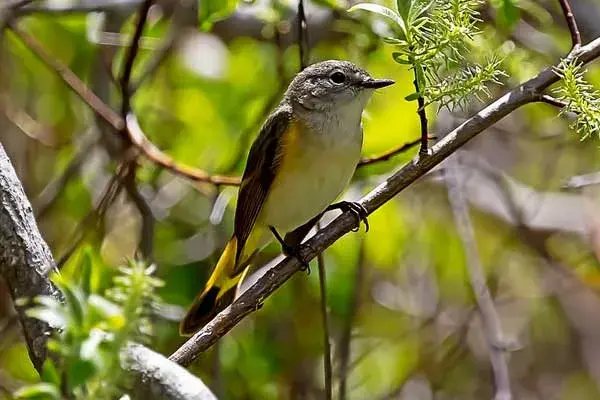
- Scientific name: Setophaga ruticilla
- Lifespan: up to 10 years
- Wingspan: 6.3-9.1 in
- Range In Minnesota: Throughout Minnesota
American redstarts are lively warblers with fairly long tails and flat beaks. Males are black with orange flashes in wings and tails; females are gray with yellow flashes in tails and wings.
American redstarts are summer residents of Minnesota and can be seen there from early May to early October. Their habitats include shrubby woodland edges and open and semi-open deciduous and mixed forests, often close to the water.
After breeding in the state, these long-distance migrants will move to Central America, northern parts of South America, and the Caribbean for winter.
Look for American redstarts in gardens and parks as well, and listen for their high-pitched notes that end with an accented phrase. Males and females will also use different calls, including sharp, sweet-sounding “chips” and soft “tsips.”
Source: G. Mcgrane, Public domain, via Wikimedia Commons
They can be often seen hopping among tree branches in search of insects, quickly opening their tails to scare their prey, and then catching them in the air.
These songbirds are mostly monogamous although some males might breed with several females and some females can have offspring that is not fathered by the current partner.
American redstarts have a clutch of 2-5 eggs and can be attracted to your backyard with berry plants such as magnolia and serviceberry.
Common Yellowthroat

- Scientific name: Geothlypis trichas
- Lifespan: up to 11 years
- Wingspan: 5.9–7.5 in
- Range In Minnesota: Throughout Minnesota
Common yellowthroats, also known as yellow bandits, are tiny songbirds with rounded heads, and medium-long tails. Males have brown plumage, yellow throats, yellow underparts, and black facial masks with white borders. Females look similar and have paler underparts and have no masks.
Common yellowthroats can be seen during summer throughout Minnesota, from late April to mid-October. They inhabit wetlands, especially cattail marshes, but also sedge meadows, wet meadows, and wet forests.
After breeding in the state, these songbirds will migrate to winter in the southeastern US, the Caribbean Islands, and Central America.
The song of common yellowthroats is a loud “twichety twichety twichety twich,” while their call is a soft “jip.”
Source: G. McGrane, Public domain, via Wikimedia Commons
They will spend much of their time darting low in dense thickets and fields, catching small insects and spiders.
Common yellowthroats love to nest around low areas of vegetation. They will build a cup-shaped nest and lay 3–5 eggs with both parents feeding the chicks.
American Goldfinch
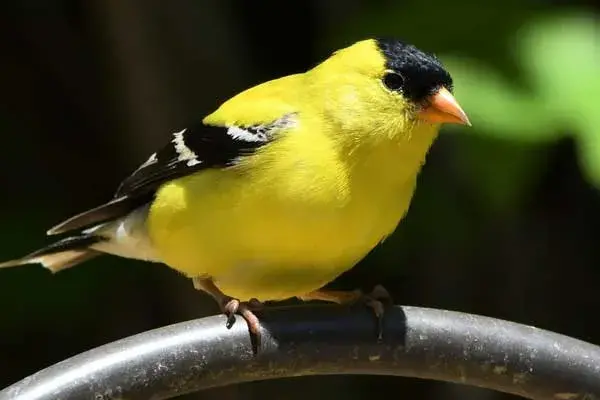
- Scientific name: Spinus tristis
- Lifespan: 3-6 years
- Wingspan: 7.5-8.7 in
- Range In Minnesota: Throughout Minnesota
American goldfinch, also known as the wild canary, is a small songbird with a small head, short tail, and long wings.
Males have bumblebee patterns when nesting, orange beaks, and white wing bars; females have duller colors, yellow tinges on their faces and breasts, and buffy wing bars.
American goldfinches are permanent residents of central and southern Minnesota; some populations in the northern parts will only breed during summer there. Those short-distance migrants will spend winter in the southern US and northern Mexico.
Look for them around weedy fields, woodland edges, and meadows. They are also common around garden feeders; to attract them, make sure to add sunflower seeds and nyjer.
The song of American goldfinches is a long series of musical twitters and warbles while their most common call sounds like they are quietly saying “po-ta-to-chips.”
Source: G McGrane, Public domain, via Wikimedia Commons
American goldfinches are the state birds of Washington, New Jersey, and Iowa.
They are herbivores that feed on seeds from many different plants, tree buds, and berries.
Male and female American goldfinches have colorful carotenoid-based orange bills that serve as indicators of the overall health of the bird; the more saturated with orange a bill is, the higher the testosterone levels the bird has.
- Further reading: More examples of stunning birds with orange beaks
Chestnut-sided Warbler
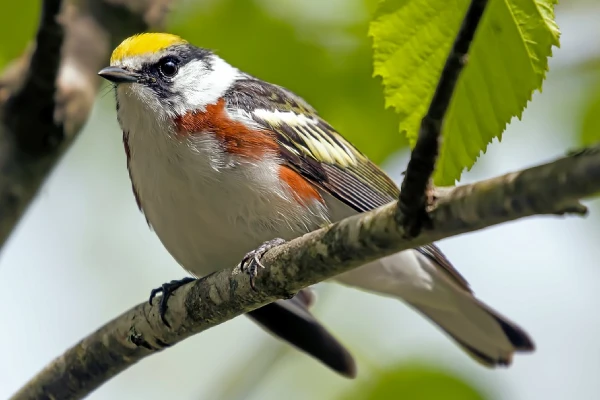
- Scientific name: Setophaga pensylvanica
- Lifespan: up to 7 years
- Wingspan: 7.1-8.3 in
- Range In Minnesota: Northern Minnesota
Chestnut-sided warblers are colorful New World warblers that breed in the eastern US and southern Canada. They have rather long tails they hold cocked (raised above the body line).
Males have bright yellow foreheads, white underparts, black teardrops, and chestnut flanks. Females have slightly duller plumage than males and lack their strong head patterns.
During the non-breeding season, males and females have bright yellow-green crowns, white eye-rings, gray faces, and underparts without streaks.
Chestnut-sided warblers are breeding residents of Northern Minnesota and are common around shrubby, deciduous woodlands, abandoned fields, and orchards of the state.
Look for them from early May/June to early October before they depart to winter in Central and South America.
Chestnut-sided warblers have 2 main songs, one is accented at the end and consists of high whistled lines people describe as “pleased-pleased-pleased-to-MEECHA,” and the other is unaccented.
Source: G. McGrane, Public domain, via Wikimedia Commons
Accented songs are used to attract females, unaccented ones are for settling territorial disputes. Some males might only sing unaccented songs; they are less successful at finding partners than those that sing both songs.
Their most common call is a harsh “chip,” similar to one of the yellow warblers.
Chestnut-sided warblers forage in tree foliage and feed on insects, spiders, and other arthropods.
They will build cup-shaped nests, close to the ground, and lay 3–5 creamy-white eggs with brown speckles.
Northern Parula
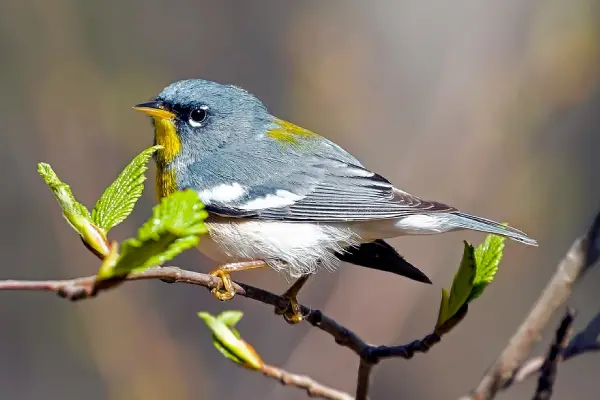
- Scientific name: Setophaga americana
- Lifespan: up to 6 years
- Wingspan: 6-7 in
- Range In Minnesota: Northern Minnesota
Northern parulas are small songbirds that have thin pointy beaks and short tails.
They are blue-gray above with olive backs, yellow below, and have burnished bibs, broken white eye arcs, and yellowish beaks and feet.
Northern parulas are summer residents of northern and northeastern Minnesota and can be found there in forests and suburbs, from spring to fall.
In other parts of the state, they can be seen as they migrate to winter in southern Florida, the Caribbean, Mexico, and northern Central America.
Northern parulas have two different songs. One is a rising buzzy trill that ends on a sharp note while the second song has distinct pauses in between bouts of the trill. They also emit a sharp “chip” call.
Source: G. McGrane, Public domain, via Wikimedia Commons
Northern parulas are monogamous warblers with rare cases of polygamy (having multiple partners).
They are omnivores that consume insects, spiders, and some berries.
Chipping Sparrow
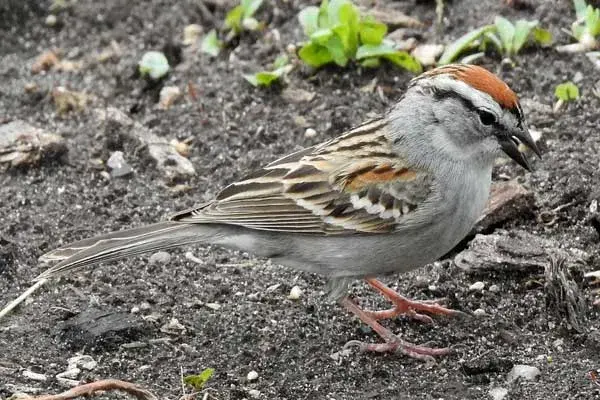
- Scientific name: Spizella passerina
- Lifespan: up to 9 years
- Wingspan: 8-9 in
- Range In Minnesota: Throughout Minnesota
Chipping sparrows are small songbirds that can be found throughout North America. They are gray-breasted and have russet crowns, light eyebrows, black eyelines, and white wing bars.
Chipping sparrows are breeding residents found in open conifers, woodland edges, yards, and gardens of Minnesota. They can be seen in the state from late March to early November.
After breeding in Minnesota, these tiny songbirds will migrate to winter in the southern US and Mexico.
Listen for the song of male chipping sparrows that is a long, dry trill of evenly spaced, almost mechanical-sounding chips. To communicate with others, they will emit a single “chip” call. Their alarm call is a long “zeee.”
Source: G. McGrane, Public domain, via Wikimedia Commons
These delicate and active sparrows are omnivores that forage on the ground and mainly consume seeds and some insects during the breeding season.
When the winter comes, chipping sparrows become social and form large flocks, together with other birds.
There are two subspecies of these sparrows with red heads, the eastern and the western chipping sparrows.
Common Redpoll
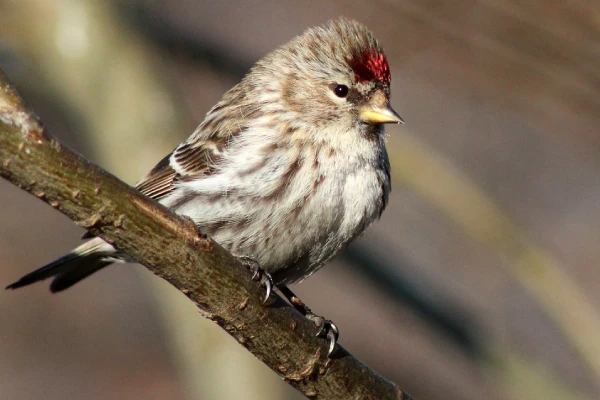
- Scientific name: Acanthis flammea
- Lifespan: up to 8 years
- Wingspan: 8.25-8.75 in
- Range In Minnesota: Northern Minnesota
Common redpolls are small finches weighing from 0.42 to 0.56 oz. Males are goldfinch-sized and have red foreheads, streaked backs and flanks, and white rumps. Females are brown and streaky.
Common redpolls are winter residents in Northern Minnesota and are common around open woodlands, weedy fields, woodland edges, and fence rows of the state. The best time to see them there would be from early October to late May.
Common redpolls are vocal birds that have several calls: sharp chatters, nasal whistles, and rattles or trills. Their songs are a combination of their call sounds.
Source: Jonathon Jongsma, CC BY-SA 3.0, via Wikimedia Commons
They are social birds that might form large flocks together with other birds like goldfinches and siskins.
They nest in trees or brushes, using twigs, roots, bark, lichen, and hair to construct them. They will lay 3-7 speckled eggs that a female incubates.
When the winter temperatures drop, common redpolls will dig tunnels in the snow, as deep as 4 inches and more than a foot long, to stay warm.
Attract common redpolls to your backyard by adding nyjer, sunflower, and millet seeds to your feeder.
Read More: List of common birds of North Georgia
American Robin

- Scientific name: Turdus migratorius
- Lifespan: 2 years
- Wingspan: 12-16 in
- Range In Minnesota: Throughout Minnesota
American robins are migratory songbirds named after the not-so-closely related European robin. They are the state birds of Connecticut, Michigan, and Wisconsin.
Identify males by their black heads, yellow beaks, and brick-red breasts; females have duller plumage and brown heads.
American robins are permanent residents of Southern Minnesota and summer residents of Northern Minnesota. Their habitats include residential lawns and gardens, urban parks, pastures, and fragmented forests.
They breed from April to July and produce 2-3 clutches of 3-4 light blue eggs per year.
American robins have a song that is described as a “cheery” carol consisting of a string of 10 or so clear whistles. They also use a sharp “yeep” alarm call or a mumbled “tuk” when communicating with one another.
Source: G. McGrane, Public domain, via Wikimedia Commons
These birds will also sing when storms approach and when they have passed.
Outside of the breeding season, American robins like to form large flocks of birds, sometimes up to 10,000 individuals!
They are omnivores that feed on eat invertebrates, especially earthworms, and fruit.
Read More: Minnesota’s small birds
Summary
This concludes our list of songbirds in Minnesota.
Examples include different species of wrens, warblers, swallows, bluebirds, and many others.
Feel free to use this list any time you need help recognizing Minnesota’s most vocal birds.
And if you enjoyed our article, explore our other popular reads on North American songbirds: